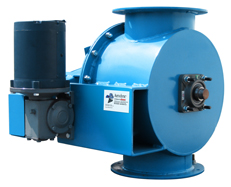About Rotary Valves
Also known as a rotary airlock valve, a rotary valve is used in a dry solids material handling system to control the feed or discharge of free-flowing bulk material without compromising the negative or positive air pressure used in the system.
A rotary valve’s design is similar to a revolving door by which one might enter a building: material must pass through a rotating chamber in order to reach the opening on the other side. The turning vanes of the rotary valve are tightly spaced to the valve walls, creating an airlock. Vanes may be tipped with hardened metal or flexible wipers. This rotary valve is motor driven; the motor and its controls must be part of the specification.
Common applications for rotary valves include pneumatic conveying, gravity conveying, gravity discharging, and volumetric metering. With these applications, they are commonly used with bag house hoppers, storage bins, and dust collection systems.
The seal of this style valve is not perfect and is therefore suited to low and moderately pressurized systems where a small air leak is acceptable. Its design is compatible with high temperature applications, and models are available for this purpose. Heavy duty valves, such as Aerodyne’s Rhino Rotary H Valve™, are available that can process abrasive and stringy materials.


